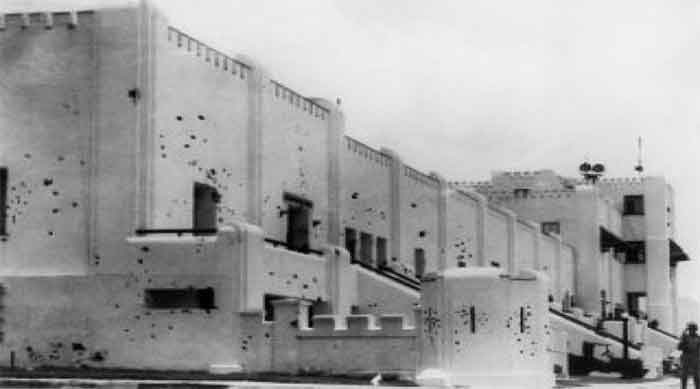
68 years ago, on July 26, 1953, an angry young lawyer, Fidel Castro, led a small band of armed men in a failed attempt to seize the Moncada barracks in Santiago de Cuba, in Oriente province. Nearly one-half of the rebels were killed – most of them died under or following torture. While Fidel and his young comrades did not succeed in their offensive, the date nevertheless became synonymous with the fiery beginning of the Cuban Revolution. Fidel was tried before a Batista court and sentenced to 15 years in prison. Less than two years later, however, and on the occasion of Fulgencio Batista’s 1954 post-coup election victory, the dictator, seeking to legitimize himself in the face of broad opposition from working-class and bourgeois forces, declared an amnesty and freed all Cuba’s political prisoners, including Fidel.
Fidel represented himself in court and defended his attack on Moncada. The concluding statement of his four hours long speech proved to be prophetic: “I do not fear the fury of the miserable tyrant who snuffed out the life of 70 brothers of mine. Condemn me, it does not matter. History will absolve me.” And it did. Two years later, Fidel and 80 guerrillas arrived in Cuba on a rickety wooden yacht – the Granma. They began a two-year guerrilla war in the Sierra Maestra, which overcame the violence of the US-backed, Batista forces. The revolutionaries built organic links with Cuba’s peasant masses and embedded themselves in the cities through well-organized support networks.
Their July 26 Movement, opening with confrontations at local Batista outposts, ultimately vanquished the primary component of the army in Santiago de Cuba. Commanders of the revolution, including Che Guevara and Camilo Cienfuegos, led military columns that repelled the numerically strong but increasingly demoralized Batista units across Cuba. How did all this happen? In 1823, US Secretary of State John Quincy Adams declared the future annexation of Cuba as inevitable. “These islands [Cuba and Puerto Rico] are natural appendages of the North American continent and one of them, Cuba, almost within sight of our shores, from a multitude of considerations, has become an object of transcendent importance to the commercial and political interests of our Union…these are the laws of political as well as physical gravitation.”
In the same year, US President James Monroe crafted the Monroe Doctrine. It asserted that the weakening of the European powers’ grip on the Americas had turned the western hemisphere into the exclusive sphere of influence of the US. This doctrine would be more concisely restated by Woodrow Wilson’s Secretary of State Robert Lansing (1864-1928): “In its advocacy of the Monroe Doctrine, the United States considers its own interests. The integrity of other American nations is an incident, not an end. While this may seem based on selfishness alone the author of the Doctrine had no higher, or more generous, motive in its declaration.” In 1898, the US invoked the Monroe Doctrine to take over Cuba and Puerto Rico from the Spanish ruling class.
In the 1860s, Cuba had, under the direction of its landed class, united against Spanish rule. The revolt was crushed after a show of Spanish barbarism. Plummeting sugar prices disrupted the Cuban economy, provoking a new mutiny in 1895, led by plantation owners. The Spanish reaction was inhumane – for the first time on the globe, reconcentrados, concentration camps were built to torture Cubans. 20% of Cuba’s population (350,000) died during the years of war. US entry into the conflict trounced the Spanish. However, the constant battles had sapped Cuba’s landowning class of all its strength, thereby rendering it incapable of resisting the island’s conversion into a US neo-colony, with a permanent military base at Guantánamo.
The urban rich became the beneficiaries of the US companies that occupied the country. Tariq Ali writes:
“US capital invested in Cuba was seven times greater than in the rest of South America. In the 1950s a building boom helped create a new class of Cuban businessmen. Occasionally they dreamed of grandeur and used their large fortunes to buy back the old plantations from US companies, but always stressed their own subordination to the imperial presence. They were parasites and happy with the niche that had been granted them. Cuba’s fake parliamentary regime was venal. Its politicians regularly looted the country’s exchequer, and gang wars ravaged the cities. It was, in short, a complete debacle.”
Cuba’s situation continued to deteriorate. Batista’s dictatorship was totally hated by the subaltern population. It also had no serious support from the rich – Batista was considered untrustworthy and an adventurer (in 1933, as a sergeant he had, together with student groups, organized a successful revolt against his own High Command). The autocrat’s over-dependence on Washington and the Mafia rapidly isolated him. In short, Cuba was undoubtedly the weakest link in the chain of military regimes that pockmarked Latin America. And this allowed the attack on Moncada barracks to ignite a world-historic process of radical change, namely the Cuban Revolution.
Yanis Iqbal is an independent researcher and freelance writer based in Aligarh, India and can be contacted at [email protected]
Related posts:
Related posts:
Views: 0
 RSS Feed
RSS Feed

















 July 27th, 2021
July 27th, 2021  Awake Goy
Awake Goy  Posted in
Posted in  Tags:
Tags: 
















